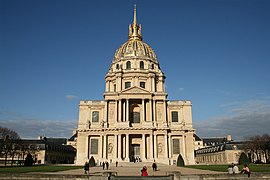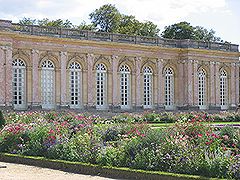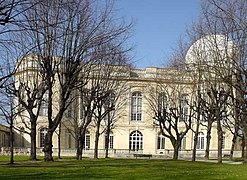Jules Hardouin-Mansart
Jules Hardouin-Mansart (Paris, April 16, 1646 - Marly-le-Roi, France, May 11, 1708), French architect, one of the most important of the century XVII, considered the pinnacle of French Baroque architecture, a style that served to magnify the name of Louis XIV.
Born Jules Hardouin, he trained with his cousin François Mansart, a renowned architect who initiated the classical tradition in French architecture, from whom he would inherit his collection of plans and drawings, as well as his last name. He would also train with Libéral Bruant, who was then the chief architect of the Hôtel des Invalides , the war veterans' hospital in Paris. After designing the plans for the Château de Clagny, for Madame de Montespan, he earned the esteem of Louis XIV.
His important position in a France that was the most important nation in Europe, allowed him to create the most significant monuments of his period, and set the trend that French late-Baroque architecture would take. French architecture spread its influence throughout Europe, reaching Saint Petersburg, and even Constantinople. It should also be noted, however, that it is speculated that due to his important bureaucratic position, it is thought that he was really not very responsible for the projects that were built with his name, criticisms that underestimate the discipline of control within an architecture studio. classic cut.
Architecture
His first work for the French monarch was the extension of the palace of Saint-Germain-en-Laye. When Louis XIV moved his court to Versailles, Mansart was required to carry out the expansion works in 1675. He became the King's First Architect in 1681, and carried out all the works on the Palace of Versailles, including the North and South wings, the Royal Chapel (together with Robert de Cotte) and the famous Hall of Mirrors, decorated by Charles Le Brun, his collaborator. Outside the palace, he built the manor house of the Grand Trianon and the Orangerie, as well as outer residences such as the Palais de Marly (begun 1679). He was appointed Superintendent of the Royal Buildings in 1699.
Mansart used the mansard roof, named after his great-uncle François Mansart, at the Palace of Dampier-en-Yvelines, built for the duc de Chevreuse, the son-in-law of Jean-Baptiste Colbert, the king's minister and the promoter of the Academy of Architecture, which he founded in 1671. The palace, with a typically French structure, in the shape of a U, and with a paved access courtyard (cour d'honneur), protected by an iron gate, and closed by the lateral bodies of the building (corps de logis), joined by symmetrically arranged balustrades. At the back, a paved path runs in the direction of the axis, with flower beds on both sides, with ponds designed by André Le Nôtre.
Other of his best-known works in Paris are the Pont-Royal, the Saint-Roch church, the great domed church of Saint-Louis-des-Invalides, in the Hôtel des Invalides (1680), Place des Victoires (Place des Victoires) (1684–86) and Place Vendôme (1699). Most of these works can be seen today, although some were modified throughout the XIX century, such as Place Vendôme.
Works
- 1667 and 1685-1690: Hôtel de Sagonne, rue des Tournelles, Paris
- 1669-1671: Petit hôtel de Guénégaud, impasse Conti, dans l'enceinte de la Monnaie de Paris à Paris 6ème (first known work by J. Hardouin-Mansart)
- 1673-1676: ville d'Arles hotel
- 1673: Chapelle de la Communion à Saint-Séverin, Paris
- 1674-1677: château de Val, in Saint-Germain-en-Laye
- 1675-1678: château de Clagny, in Versailles (disappeared)
- 1676-1680: Pavillon de Manse, in Chantilly
- 1676-1706: Completion of the hotel des Invalides in Paris, in particular the church of Saint-Louis-des-Invalides
- 1677: Ala sur patio of the hotel of Chaules, Plaza de los Vosges de Paris
- 1677-1679: Palais de l'Evêché, Castres
- 1678: Hôtel de Fieubet, quai des Célestins, Paris
- 1679: Hôtel de Noailles, Saint-Germain-en-Laye
- 1679-1699: Marly Palace in Marly-le-Roi (disappeared)
- 1680-1681: works in the château of Saint-Germain-en-Laye (old)
- 1682-1686: château de Dampierre, Dampierre-en-Yvelines
- 1683-1684: Orangerie (disappeared) and works in Chantilly's small château
- 1684: Finalization of the château chapel of Chambord
- 1684-1686: place des Victoires, in Paris
- 1685: château of Boury, in Boury-en-Vexin
- 1685-1686: restoration of the palais des ducs de Bourgogne, Salle des États, in Dijon
- 1685-1694: Place of the Conquests in Paris (now place Vendôme)
- 1685-1690: Pont-Royal of Paris
- 1686: orangerie del château de Sceaux
- 1686: Maison Royale de Saint-Louis, Maison d’éducation des demoiselles, Saint-Cyr-l'École
- 1686, Place Royale in Dijon
- 1686-1687: Transformation de l’aile sud du château et réalisation du grand escalier, en Saint-Cloud (disappeared)
- 1687-1688: planes of the Eglise Notre-Dame de l'Assomption, in Chantilly
- 1688: Saint-Vigor church in Marly
- 1692: Orangerie du château de Thouars
- 1694: plans of the château of L'Isle in the canton of Vaud
- 1695-1708: Gothic-style reconstruction in Poissy, Saint-Louis eglise, frappée par la foudre
- 1697-1698: Hôtel de Lorge, Paris (disappeared)
- 1698-1704: embellishment of the Meudon château for the Grand Dauphin
- 1699: Modification de la Grande cascade du parc, Saint-Cloud
- 1699-1700: gallery du Palais-Royal de Paris (disappeared)
- 1699-1700: château de Vanves, current administrative pavilion of the lycée Michelet
- 1701-1703: Reconstruction of the City of Lyon, destroyed by a fire
- 1703: Hôtel de Montargis, Paris (disappeared)
- 1704-1705: Moulins bridge (disappeared)
- 1706-1708: new château of Meudon (disappeared)
- 1708-1710: chapelle de la Vierge and completion of the choir of the Église Saint-Roch in Paris
- At the Palace of Versailles:
- 1670-1672: Hôtels place d’armes (disappeared)
- 1677: forest of Dômes (disappeared)
- 1678-1684: Galerie des Glaces et salons de la Guerre et de la Paix
- 1679: Wings of Ministers
- 1679-1689: facade in front of the park, the wings of portraits North and South
- 1679-1684: Petite and the Great Ecurie, the nouvelle orangerie
- 1682-1684: Grand Commun
- 1684: Eglise (disappeared) et couvent des Récollets
- 1684: Colonnade forest
- 1687-1688: Grand Trianon
- 1689-1710: chapelle royale e église Notre-Dame de Versailles
- 1702: Pavillons de la Ménagerie
and also:
- The park of the château d'Écouen
- The château of Boufflers
- The chapel of the château of Serrant, in Saint-Georges-sur-Loire
- The château de l'Étang, in Audigny

















